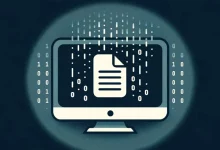The Rise Of Hacker Alliances
At the start of 2024, the digital underworld witnessed a seismic shift as hacking groups LulzSec France and Moroccan Black Cyber Army forged an ominous hacker alliances with a singular focus – Denmark.
The unsettling proclamation, “LulzSec X Moroccan Black Cyber Army against Denmark,” echoed across the virtual realm, accompanied by a cryptic image, leaving security experts on high alert. This unexpected collaboration marked a departure from the conventional motives of greed, hinting at a new era where cyber threats transcend national borders and unite under shared objectives.
To highlight this emerging trend, another announcement reverberated through the clandestine corridors of the internet. Beregini, a shadowy hacking group, brazenly absorbed Killmilk, the former leader of the pro-Russian cybercrime juggernaut Killnet, into its ranks. The revelation unfolded dramatically through a flashy video, complete with cyberattack maps and a narrative weaving Killmilk’s story into the enigmatic fabric of Beregini.
However, these weren’t isolated incidents. Preceding these events was the aftermath of a successful dismantling of Alphv ransomware infrastructure. In an unforeseen turn, LockBit and BlackCat/APLHV, two formidable hacker collectives, joined forces, creating ripples across the digital landscape. Their goal: to establish a ransomware cartel, presenting a united front against law enforcement crackdowns, such as the recent FBI action targeting ALPHV’s leak website.
These groundbreaking developments were unveiled through cryptic messages on the dark web, the notorious world where cybercriminals converge to communicate and orchestrate their illicit activities.
In this landscape of evolving hacker alliances and unforeseen collaborations, questions arise about the motives that propel these cyber adversaries beyond the traditional world of greed.
This article seeks to unravel the complexities surrounding such collaborations, exploring the reasons behind these hacker alliances, their manifestations in the vast expanse of cyberspace, the political influence they wield, and the potential geopolitical impacts.
Why Do Cyber Misfits Forge Unholy Alliances?
These digital renegades aren’t merely on a quest for a shared pot of gold; their motives go beyond individual pursuits. At the core of these unholy alliances lies the fundamental principle of ‘Strength in Numbers.’
Picture it as a digital heist where each participant contributes unique skills and tools to the collective table. These collaborations resemble a virtual Avengers squad, pooling expertise, knowledge, and resources to take on high-profile targets or dismantle Fort Knox-like defenses.
Pankaj Kumar Saxena, Founder & Director of ewandzdigital Inc., sheds light on the driving forces behind these collaborations, stating, “One primary driver is the shared expertise and resources among hackers with different skills, creating a formidable force with enhanced capabilities. This collaboration results in more sophisticated and multifaceted attacks, leveraging the combined skills and resources of the group members. Another motive is the pursuit of monetary gains, where hackers collaborate for larger payouts through financially motivated cybercrimes, pooling resources to maximize impact and profits.”
However, these alliances go beyond being a mere digital tag team; they are strategic maneuvers aimed at making a statement. It’s akin to a coordinated dance of chaos, where hackers unite to magnify their impact. Whether it’s seeking a broader reach, inflicting more significant damage, or chasing that fleeting fifteen minutes of fame in the media spotlight, collaboration enables them to achieve feats that solo missions cannot.
Nathan Wenzler, Chief Cybersecurity Strategist at Tenable, emphasizes the parallels between hacker alliances and collaborative efforts in corporate environments, stating, “In many ways, hacker groups work the same hackers who group into alliances do so to share information, be more efficient and effective at launching attacks and potentially share the workload to accomplish similar goals.”
“For example, instead of trying to write a piece of malware from scratch to take advantage of a particular exploit, a hacker could instead reach out to their collaborators and see if someone had already written code way that corporations and other businesses do, and they gain the same benefits from working together that most of us would within an office or virtual workspace,” Wenzler added further.
In the vast expanse of cyberspace, the classic buddy system finds its place – mutual protection. Forming a network of cyber allies serves as a digital neighborhood watch, offering support and early warnings against potential cyber threats. This interconnected defense mechanism embodies a contemporary manifestation of the age-old adage: safety in numbers.
These collaborations, however, aren’t solely born out of convenience; they often stem from shared beliefs. Whether driven by hacktivism or state-sponsored cyber warfare, ideological alignment becomes a potent adhesive. It’s akin to discovering a cyber soulmate who shares identical political or social goals, elevating the collaboration beyond mere lines of code to a shared cause.
And then, there’s the ever-present motive that has fueled mischief-makers since the inception of hacking – financial gain. These partnerships often form to undertake massive cybercrime operations or share the spoils from lucrative ventures such as stolen data or ransom demands.
Saxena further elaborates on these motives, explaining, “Another motive is the pursuit of monetary gains, where hackers collaborate for larger payouts through financially motivated cybercrimes, pooling resources to maximize impact and profits. Additionally, hacker alliances aim to increase their attack surface by collectively targeting a broader range of organizations or industries.
This strategy involves coordinated attacks, occurring simultaneously or in sequence, overwhelming defenses and challenging targeted entities in their response efforts.”
Political Motives Influencing Hacker Alliances
In the intricate tapestry of hacker alliances, political motives emerge as a formidable force, steering collaborations beyond the traditional realms of greed.
A notable aspect unfolds in the realm of Government-Sponsored Cyberwarfare, where states unite with hackers to launch targeted attacks against other nations or disrupt their critical infrastructure. This not only blurs the lines between statecraft and cyber warfare but also underscores the increasingly pivotal role hackers play in geopolitical maneuvers.
Hacktivism and Activism represent another influential force, as groups leverage hacking to propel political agendas, protest injustices, or embarrass governments on the global stage. These alliances serve as digital vanguards for political movements, utilizing their cyber prowess to amplify voices that might otherwise be suppressed.
“The alignment of hackers with political agendas is concerning, evident in instances like APT groups conducting cyber espionage for nation-states and hacktivist campaigns targeting organizations aligned with specific ideologies. Notably, the collaboration between ransomware groups and certain nations blurs the lines between state-sponsored and criminal activities. This trend poses challenges for attribution and escalates the impact of cyber operations on geopolitics. A recent example is the SolarWinds cyberattack, where suspected Russian-backed hackers targeted U.S. government agencies and private companies, showcasing the intersection of cyber threats and political motivations,” highlights Pankaj Kumar Saxena.
Online Protests and Dissent take a digital turn as hacker alliances coordinate attacks to disrupt government websites or silence dissident voices. This form of digital dissent reshapes the landscape of political protest, extending the battleground beyond physical streets to the vast expanse of cyberspace.
The manipulation of Elections and Political Processes raises concerns as hacker alliances engage in campaigns aimed at influencing voters, disrupting elections, or spreading disinformation. The potency of these cyber maneuvers to sway public opinion and undermine the democratic process serves as a stark reminder of the evolving challenges faced by governments worldwide.
In a more ominous vein, Cyberterrorism and Destabilization emerge as motives, with hackers utilizing their skills to sow fear, disrupt essential services, and undermine government authority. This form of hybrid warfare underscores the potential for hacker alliances to become conduits for state-sponsored acts of destabilization, creating a volatile environment in the digital world.
On asking Wenzler, he provides a fascinating insight into the evolving tactics of these digital provocateurs. In his words, “The most interesting trend I’ve seen with political hacktivists is that their attacks tend to shift towards quieter and less visible cyberattacks compared to previous years. It’s like they’ve adopted a ‘lying in wait’ strategy, emphasizing stealth in their operations against targets.”
Wenzler continues to shed light on their calculated approach: “This doesn’t imply a reduction in their damaging capabilities or the frequency of attacks. Instead, it signifies a deliberate effort to operate covertly, avoiding detection by anyone within the targeted organization. They infiltrate the entire network, identifying all assets, applications, databases, and other devices, creating multiple potential attack points and methods for themselves.”
He goes on to explain that even when they achieve a near-complete compromise of the environment, they may not launch noticeable or damaging attacks immediately. Instead, they patiently bide their time, waiting for a situation influenced by external political or social circumstances.
“These hacktivists, motivated by causing harm rather than financial gain, exhibit patience and methodical precision in launching cyberattacks. Their goal is to ensure the maximum amount of political, reputational, and, yes, financial damage to the targeted organization.”
Media Disclaimer: This report is based on internal and external research obtained through various means. The information provided is for reference purposes only, and users bear full responsibility for their reliance on it. The Cyber Express assumes no liability for the accuracy or consequences of using this information.





